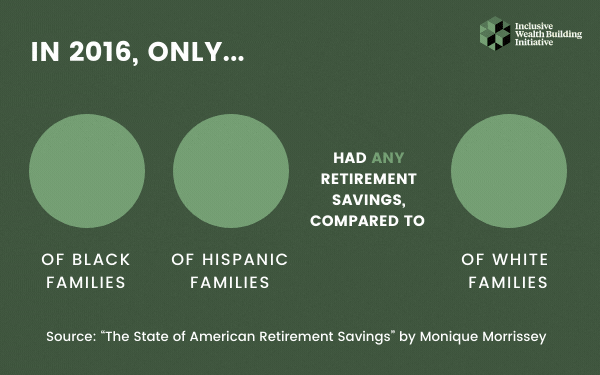by Kenneth Megan and Angelica Banks
Many Americans risk being insecure in retirement, with roughly half of U.S. households on track to take a cut in their standard of living as they age. This challenge is particularly acute among people of color, as just 41 and 35 percent of Black and Hispanic families, respectively, had any retirement savings in 2016, compared to 68 percent of white families. Similarly, the typical Black and Hispanic household approaching retirement has just around half the total retirement wealth of the typical white household.1 Ultimately, these disparities underscore the need for federal policies that help low-income workers build wealth and save for retirement, as such interventions would have especially positive effects on Black and Hispanic workers.
Unpacking Racial Disparities in Retirement Security

Communities of color in the United States have suffered from long-term labor market discrimination, unequal access to education, and other socioeconomic challenges, which have led to lower wages relative to white workers, as well as over-representation in occupations with lower levels of retirement coverage. Black and Hispanic private sector employees are 15 and 42 percent less likely to have access to employer retirement plans than white employees. Workers who do not contribute to tax-advantaged retirement plans miss out on the billions of dollars in federal subsidies that they provide. Indeed, of the $276 billion in federal tax expenditures to support retirement savings in 2019, just around one percent went to households in the bottom income quintile (see our previous blog for more on retirement tax expenditures).
Lower income levels and a higher likelihood of being financially insecure also hampers retirement savings among workers of color. The poverty rate among Black and Hispanic Americans is 20 and 17 percent, compared to 8 percent among non-Hispanic whites. And median wealth among Black and Hispanic households stands at around $24,000 and $36,000, respectively, compared to $143,000 for white households. Lower levels of financial resources makes saving more difficult, and is a driving force behind racial disparities in retirement security.
Promoting retirement security and wealth generation
To strengthen retirement security for workers who have been traditionally left behind, EIG recommends developing a federal program that mirrors features of the Thrift Savings Plan (TSP), the retirement plan for federal workers. Under this approach, workers who lack access to an employer-sponsored retirement plan would be auto-enrolled into a retirement savings plan, which would be characterized by simple and low-cost investment options. Low- and middle-income workers would receive federal matching contributions, which would by default help to advance retirement equity.
Importantly, the TSP is a proven model for strengthening retirement security among marginalized workers. This is the result of key design features, namely automatic enrollment and matching contributions. According to the Congressional Budget Office, after the TSP adopted these features, enrollment increased from 63 to 94 percent among Black workers, and from 55 to 95 percent among workers in the bottom third of earnings.2
Automatic enrollment is effective because it mitigates the inertia that occurs when workers are required to actively enroll in retirement plans, whereas matching contributions both incentivize savings and spur long-term wealth creation. It is also important to note that the low-cost investment options offered by the TSP help to ensure that workers are not overburdened with fees and are instead socking away more for retirement.
Ultimately, America’s private retirement system is characterized by inequities that fall predictably along racial and socioeconomic lines. Providing access to a program that mirrors key elements of the TSP would increase access to retirement savings vehicles among those who have traditionally been unable to participate, as well as enable low-income Americans to grow a nest egg and retire with dignity.
Notes
1 “Typical” in this instance is defined as the average household within the middle income quintile.
2 These outcomes occurred across multiple cohorts of workers hired during different time periods.




